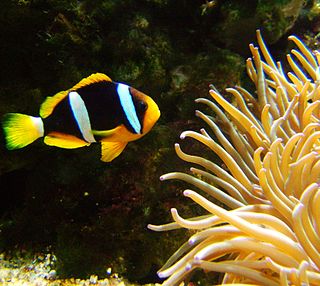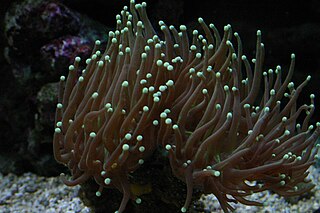
The Portuguese man o' war, also known as the man-of-war or bluebottle, is a marine hydrozoan found in the Atlantic Ocean and the Indian Ocean. It is considered to be the same species as the Pacific man o' war or bluebottle, which is found mainly in the Pacific Ocean. The Portuguese man o' war is the only species in the genus Physalia, which in turn is the only genus in the family Physaliidae.

Sea cucumbers are echinoderms from the class Holothuroidea. They are marine animals with a leathery skin and an elongated body containing a single, branched gonad. They are found on the sea floor worldwide. The number of known holothurian species worldwide is about 1,786, with the greatest number being in the Asia-Pacific region. Many of these are gathered for human consumption and some species are cultivated in aquaculture systems. The harvested product is variously referred to as trepang, namako, bêche-de-mer, or balate. Sea cucumbers serve a useful role in the marine ecosystem as they help recycle nutrients, breaking down detritus and other organic matter, after which bacteria can continue the decomposition process.

Clark's anemonefish, also known as the yellowtail clownfish, is a marine fish belonging to the family Pomacentridae, the clownfishes and damselfishes.

The lion's mane jellyfish, also known as the giant jellyfish, arctic red jellyfish, or the hair jelly, is one of the largest known species of jellyfish. Its range is confined to cold, boreal waters of the Arctic, northern Atlantic, and northern Pacific Oceans. It is common in the English Channel, Irish Sea, North Sea, and in western Scandinavian waters south to Kattegat and Øresund. It may also drift into the southwestern part of the Baltic Sea. Similar jellyfish – which may be the same species – are known to inhabit seas near Australia and New Zealand. The largest recorded specimen was measured off the coast of Massachusetts in 1865 and had a bell with a diameter of 210 centimetres and tentacles around 36.6 m (120 ft) long. Lion's mane jellyfish have been observed below 42°N latitude for some time in the larger bays of the East Coast of the United States.

Heteractis magnifica, also known by the common names magnificent sea anemone or Ritteri anemone, is a species of sea anemone belonging to the Stichodactylidae family native to the Indo-Pacific area.

Sea apple is the common name for the colorful and somewhat round sea cucumbers of the genus Pseudocolochirus, found in Indo-Pacific waters. Sea apples are filter feeders with tentacles, ovate bodies, and tube-like feet. As with many other holothurians, they can release their internal organs or a toxin into the water when stressed.

The sebae anemone, also known as leathery sea anemone, long tentacle anemone, or purple tip anemone, is a species of sea anemone belonging to the family Stichodactylidae and native to the Indo-Pacific area.

Alcyonacea are an order of sessile colonial cnidarians that are found throughout the oceans of the world, especially in the deep sea, polar waters, tropics and subtropics. Whilst not in a strict taxonomic sense, Alcyonacea are commonly known as soft corals. The term "soft coral" generally applies to organisms in the two orders Pennatulacea and Alcyonacea with their polyps embedded within a fleshy mass of coenenchymal tissue. Consequently, the term "gorgonian coral" is commonly handed to multiple species in the order Alcyonacea that produce a mineralized skeletal axis composed of calcite and the proteinaceous material gorgonin only and corresponds to only one of several families within the formally accepted taxon Gorgoniidae (Scleractinia). These can be found in order Malacalcyonacea (taxonomic synonyms of include : Alcyoniina, Holaxonia, Protoalcyonaria, Scleraxonia, and Stolonifera. They are sessile colonial cnidarians that are found throughout the oceans of the world, especially in the deep sea, polar waters, tropics and subtropics. Common names for subsets of this order are sea fans and sea whips; others are similar to the sea pens of related order Pennatulacea. Individual tiny polyps form colonies that are normally erect, flattened, branching, and reminiscent of a fan. Others may be whiplike, bushy, or even encrusting. A colony can be several feet high and across, but only a few inches thick. They may be brightly coloured, often purple, red, or yellow. Photosynthetic gorgonians can be successfully kept in captive aquaria.

Chromis viridis is a species of damselfish. Individuals tend to be iridescent apple-green and light blue, and reach a maximal length of 10 cm.

Holothuria atra, commonly known as the black sea cucumber or lollyfish, is a species of marine invertebrate in the family Holothuriidae. It was placed in the subgenus Halodeima by Pearson in 1914, making its full scientific name Holothuria (Halodeima) atra. It is the type species of the subgenus.

Enypniastes is a genus of deep-sea sea cucumber. It is monotypic, being represented by the single species Enypniastes eximia. Due to its unique appearance, the species has been dubbed the headless chicken fish, headless chicken monster, and the Spanish dancer. It is also known as the swimming sea cucumber, and some are called the pink see-through fantasia.

Clavatula virgineus, also known as the Virgin Olive, is a species of sea snail belonging to the Clavatulidae family of marine gastropod mollusks. These snails have elongated spiral shells with intricate patterns and bright colors. They inhabit various marine environments worldwide, from coastal areas to ocean depths. Clavatula virgineus plays important roles in marine ecosystems, contributing to biodiversity and ecological balance.

Pseudoceros dimidiatus, the divided flatworm or tiger flatworm, is a species of flatworm in the genus Pseudoceros, belonging to the family Pseudocerotidae.

The tubular hydroid is a species of hydroid cnidarian, and is found in temperate coastal waters. It is a member of the family Tubulariidae.

Diploastrea heliopora, commonly known as diploastrea brain coral or honeycomb coral among other vernacular names, is a species of hard coral in the family Diploastreidae. It is the only extant species in its genus. This species can form massive dome-shaped colonies of great size.

The Great Southern Reef is a system of interconnected reefs that spans the southern coast of continental Australia and Tasmania and extends as far north as Brisbane to the east and Kalbarri to the west. It covers 71,000 km2 (27,000 sq mi) of ocean and straddles five states, running along the coast for 8,000 km (5,000 mi).

Euphyllia glabrescens is a species of large-polyped stony coral belonging to the family Euphylliidae. Its common name is the torch coral due to its long sweeper tentacles tipped with potent cnidocytes. It is a commonly kept species in the marine aquarium hobby, particularly specimens from Indonesia and Fiji, who fulfilled annual export quotas of 28,000 and 6,000 pieces, respectively, in 2005.
Psolus chitonoides, also known as the slipper sea cucumber, armoured sea cucumber, creeping armoured sea cucumber, or creeping pedal sea cucumber, is a species of sea cucumber in the family Psolidae. It is found in shallow water on the western coast of North America. The scientific name "chitonoides" means resembling a chiton.

Synaptula recta, sometimes known as the gut-like sea cucumber, is a species of sea cucumber in the family Synaptidae in the phylum Echinodermata. It occurs in shallow water in the tropical Indo-Pacific region.

Holothuria pervicax is a species of sea cucumber in the genus Holothuria. It is commonly called the stubborn sea cucumber due to its inability to be kept alive in captivity. It is commonly found buried beneath rocks on reefs in warm waters.


















